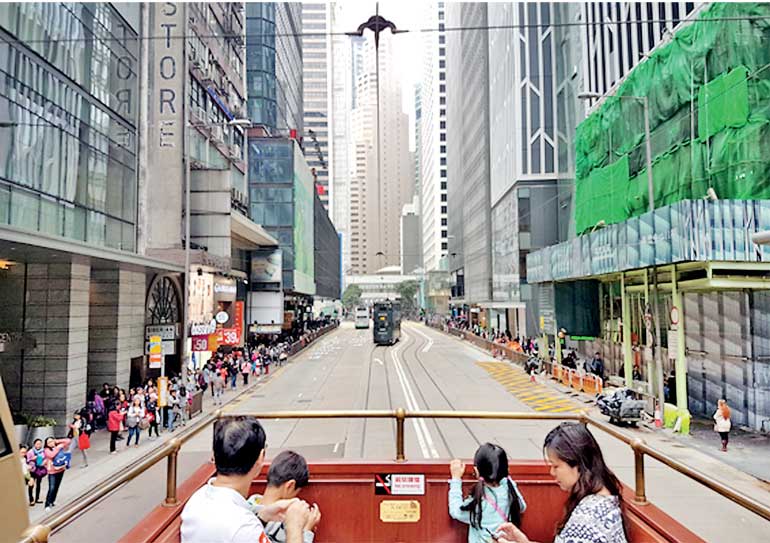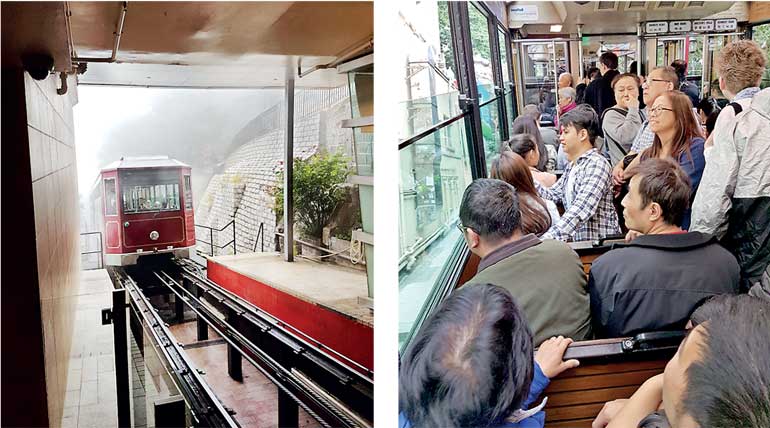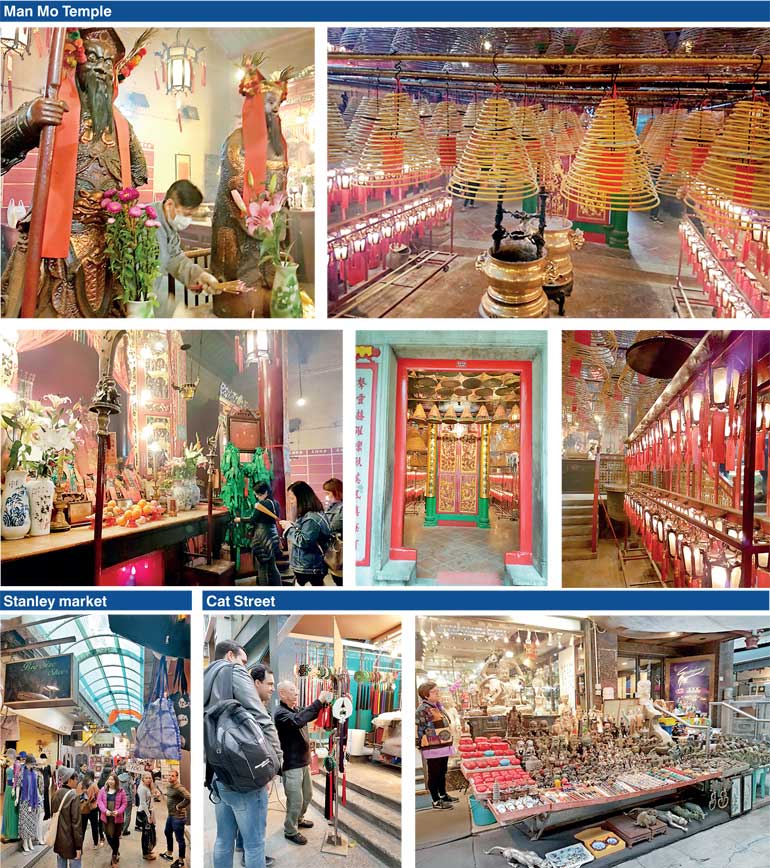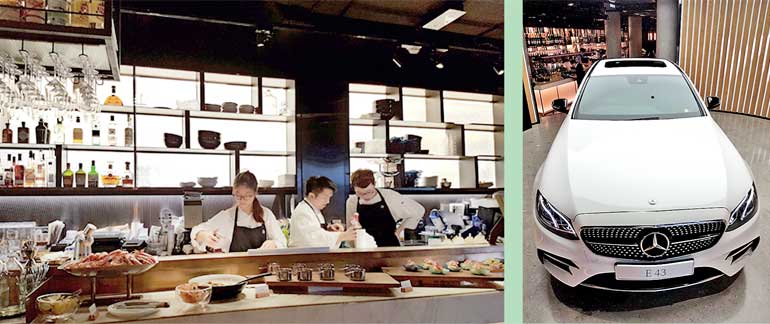Tuesday Dec 23, 2025
Tuesday Dec 23, 2025
Wednesday, 5 April 2017 01:47 - - {{hitsCtrl.values.hits}}

In 2016 there were over 56 million visitors to Hong Kong and the Special Administration Region (SAR) of the People’s Republic of China has been enjoying over 50-60 million visitors annually for several years. Overnight visitors amount to over 26 million. Nearly 75% of the visitors are from the Mainland China. However in recent years tourists from other parts of the world have been on the steady rise. Japanese, Koreans, Singaporeans, Americans, Australians and Indians are among those. Of late Sri Lankans have joined the growing numbers to savour exciting Hong Kong.
Considering its size, just 1,106 square kilometres of land area (1,649 square kilometres of water area), the ability to draw on average 50-60 million visitors annually is impressive. If one were to discount those arriving from the Mainland China, then Hong Kong’s appeal to near 15 million visitors annually from the rest of the world is more significant.
Hong Kong figures among a small group of territories which have succeeded in becoming tourism icons in the world, offering valuable lessons to others, including developing countries in tourism development and destination marketing.Hong Kong is also a model for the rest of the world given its economic success by being a financial and logistics hub.
Land is sacred in Hong Kong as it is ranked as the world’s fourth most densely populated territories. Its population of 7.3 million made up from different nationalities make Hong Kong vibrant and brings about a fusion of many cultures and cuisine.
Given its rich appeal and diversity, trying to explore Hong Kong in two or three days may be futile.The more discerning and seasoned travellers say one needs many weeks to properly enjoy Hong Kong. However a week stay may help savour a more memorable experience and for individuals and families with limited time, a shorter three-five day tour will provide a fair degree of joy of discovery and reinforce a repeat trip to explore more.
The Daily FT recently had the opportunity to undertake a three-day tour to Hong Kong to find out some of the popular or must-see tourist attractions, enjoy authentic and fusion cuisine as well as witness its recent economic success.
Daily direct flights to Hong Kong with Cathay Pacific
For Sri Lankans, accessibility to Hong Kong is easier.The multiple award-winning Cathay Pacific flies direct to Hong Kong on a daily basis with a flying time of about five hours, the best in this route. Cathay has a superior in-flight experience with Business Class and Economy, making its fares real value for money.
As you approach Hong Kong, what is most distinctive is the impressive skyline.Due to scarcity of land, Hong Kong has the second largest number of high rises for any city in the world. The biggest skyscraper is the 1,588 feet tall International Commerce Centre (ICC), which is the world’s 10th tallest at present.
The ICC, which also houses the world’s highest-placed hotel – the Ritz Carlton – isin close proximityto the International Finance Centre (IFC) and another iconic landmark, the Bank of China Tower, the fourth tallest. The latter when completed in 1989 was Asia’s tallest. These skyscrapers embody Hong Kong’s reputation as one of the most vibrant and biggest financial centres in the world, initially benefitting from decades of British rule and later sustained by China after the territory became a SAR in 1997.
The territory consists of Hong Kong Island, the Kowloon Peninsula, the New Territories, and over 200 offshore islands, of which the largest is Lantau Island. It is a bustling destination powered by finance, trade, shipping, tourism, shopping, entertainment and dining.
There are many tourist attractions in Hong Kong and during the Cathay Pacific-organised Daily FT’s tour involving a few other select media from Sri Lanka, a few of the most popular sites were experienced.


The Peak Tram
One must-see in Hong Kong is the Victoria Peak, the view of Hong Kong from which is breathtaking. On the day we visited The Peak, the view was disturbed by heavy smog but on a sunny day or clear night it is certainly more captivating.
With an elevation of 1,811 feet, The Peak is the highest mountain on Hong Kong Island. The Sky Terrace 428, the figure representing the height from the sea level, is picturesque.
The 1.4 kilometre travel to The Peak via the gravity-defying Peak Tram is yet another memorable experience. With origins stretching back to 1880s, the Peak Tram can accommodate around 100 passengers per ride and annually transports over four million or 11,000 daily. The Peak also houses the Madame Tussauds Hong Kong and offersshopping and dining (Lu Feng at The Peak, the Chinese restaurant by Epicurean Group being very unique and popular) experience for visitors.
Arguably the Peak Train is the most enduring emblem of Hong Kong’s unique past. It has seen war, been featured on films and television and played host to numerous dignitaries. It is said that in the early days, most people were carried to and from The Peak by sedan chair – a frail bamboo chair supported by two strong coolies. It was the most popular, if not the most comfortable mode of transport. In May 1881, an enterprising Scotsman by the name Alexander Findlay Smith devised a plan to speed up the development of new residences inThe Peak districts with the introduction of a funicular railway.
In May 1888 the Governor Sir George William des Voeuxofficiated at the inauguration of this important transport link for residents of The Peak. Since then The Peak Tram has helped to shape the face of Hong Kong’s development.The tram has been successively modernised from coal fired steam boilers to electrically powered haulage to the current microprocessor-controlled technology. The Peak Tram, one of the oldest and most famous funicular railways rises to 1,300 feet above the sea level.

Other popular places to visit in Hong Kong include the legendary ‘Man Mo’ Temple Compound comprising Man Mo Temple, Lit Shing Kung and Kung Sor built between 1847 and 1862 by wealthy Chinese merchants.
Man Mo Temple was built mainly for the worship of Man Cheong (God of Literature) and Mo Tai (God of Martial Arts). Lit Shing Kung was built for the worship of all the Chinese gods while Kung Sor served as a meeting place and a venue for dealing with matters related to the Chinese community in the neighbourhood. The magnificent Man Mo Temple Compound is a fine example of traditional Chinese vernacular architecture. It is exquisitely decorated with ceramic figurines, granite and wood carvings, plaster mouldings and murals, all of which exhibit traditional craftsmanship. It was declared as a monument in November 2010 and protected under Hong Kong’s Antiques and Monuments Ordinance.
As one enters the temple, an immediate attraction is the rows of large earth-coloured spirals suspended from the roof. In fact they are incense coils burned as offerings by worshippers of the two gods seeking blessings and favours.
In Central Hong Kong another popular place is Cat Street, which houses rows of shops selling antiques, souvenirs, fake and used or discarded items. How the street got its name is interesting.Originally the street became famous for the sale of stolen goods.In Cantonese, stolen items are called ‘rat goods’ and the people who buy them are called cats – hence its nickname ‘Cat Street’, it is said. Adjoining Cat Street and reflecting a total contrast of affluence is Hong Kong’s Hollywood Road, which is the second road to be built when the colony of Hong Kong was founded.
TsimShaTsui
The TsimShaTsui, conveniently called TST, is Kowloon’s showpiece and needs to be accessed through a ferry if staying on Hong Kong island side.TST is popular among tourists for a variety of shopping, dining and entertainment apart from museums. A popular landmark is the TST Clock Tower, listed as a declared monument in Hong Kong since 2000.
A key highlight of the Sri Lanka media tour was the ride on the open top tram, yet another popular tourist activity for its unique opportunity for a quick sightseeing. The one-hour tour on a 1920s-style open top tram, allows a tourist to witness the bustling Hong Kong streets with an in-tram video being played reminiscing how the streets and Hong Kong were in the past. This experience gives a tourist a quick flash back of Hong Kong’s past whilst enjoying its modernity.
An interesting place for shopping is Stanley Market on Hong Kong Island.It is a street full of little shops selling a wide variety of products including clothing, sportswear, toys, costume jewellery, ornaments, Hong Kong and Chinese arts and crafts and souvenirs.

Lu Feng at the Peak, Chinese Restaurant by Epicurean Group
LúFeng is a new restaurant atop The Peak in Hong Kong. Taking cue from the Old Hong Kong teahouse concept, it brings a journey across times by flawlessly showcasing the transition of theterritory’s culinary culture.
The two-storey LúFeng overlooks the magnificent South China Sea with an uninterrupted view of the tranquil Hong Kong skyline. The lower floor is designed for casual gatherings while the upper floor is for formal dining or corporate events. This Hong Kong-style Tea House brings guests down memory lane for a one-of-a-kind dining experience.
LúFeng’s menu is a wonderful exemplar of classic dishes from the various regions of China. Guests can savour a comprehensive range of Chinese delicacies prepared by the talented culinary team helmed by Executive Chef Harry Hung.
Lu Feng is run by the Epicurean Group, one of the leading hospitality groups in Hong Kong that owns and operates a diversified portfolio of food and beverage outlets in Hong Kong, China and Singapore.

It owns and manages over 30 iconic restaurants and bars offering a diverse cuisine selection including Italian, Mexican, Continental, Spanish, International, Japanese and Chinese concepts. Popular brands include The Peak Lookout, Jimmy’s Kitchen, OsteriaFelice, Agave Tequila Y Comida, Xia Fei Society, Xia FeiShanghainese, Xia Xiao Fei, Xiao Wang Beef Noodle, Joy & Joy, Tim’s Kitchen (Elements), SUSHI SEI, NAHA, Daimon Ramen, DaimonShokudo, Daimon Family Cafe, Avenue Joffre, Fujiyama Mama, LúFeng, HON10 and Yi’s Kitchen.
The spread offered to the Sri Lankan media group was interesting. During our lunch we were served Chicken and Chives Spring Rolls, Marinated Jelly Fish in Sesame and Mustard Sauce, Crispy Tofu with Schimi and Rock Salt, Braised Beef Rib wrapped with Straw, Sauteed King Prawn in Black Truffle Sauce, Tea-Smoked Chicken, Poached Chinese Cabbage with Fresh Semen Euryales Soup, Chicken and Jujube Rice. For dessert it wasChilled Sago Cream with Mango and Pomelo.
LoongToh Yuen by Hullet House
The Sri Lanka media also enjoyed a cuisine of ‘LoongToh Yuen,’ the famous Hullett House’s signature Chinese dining restaurant at TsimShaTsui.
Embodying elements of old Hong Kong teahouse culture and King George IV chinoiserie in its inspired décor, LoongToh Yuen revives long-lost Hong Kong dishes and offers a comprehensive selection of classic dim sum and Chinese tea.
Cuisine LoongToh Yuen focuses on rejuvenated Cantonese cuisine. Chefs at LoongToh Yuen have adapted Hong Kong classics that blend the traditional with contemporary. Dim sum is available in the afternoons with an à la carte menu provided in the evenings.
The serving to Sri Lankan media group was impressive. It comprised of Soya Paste Marinated Okra, Prawn and Lotus Root Cake, Dark Fungus with Balsamic Vinegar and Spice Calamari for starters followed by Chicken and Sweet Corn Soup, Sweet and Sour King Prawn, Cheese and Scallop in crisp Taro Puff, Kung Po Chilli Chicken, Pan Fried Fillet of Grouper, Fried Noodles with Bean Sprouts and Soya and Chinese Petite Fours.
The main dining area of LoongToh Yuen draws upon Hong Kong’s vibrant Chinese culture, merging themes of the city’s markets with King George IV’s Chinese-inspired dining room. The result is a sophisticated blend of classic Hong Kong teahouses and Brighton’s Royal Pavilion, where King George IV’s chinoiserie style is best experienced.
Originally built in 1881, the historical site where Hullett House stands today is one of the four oldest surviving government buildings in Hong Kong. For more than 100 years it was occupied by Hong Kong’s Royal Marine Police.
Hullett House is named in honour of Richmond William Hullett, a 19th century English scholar who lived and worked in Asia. A dedicated botanist, it is said he discovered, amongst others, a hybrid of Bauhinia, also known as the Hong Kong orchid. The bauhinia flower with its delicate pink orchid-like leaves was adopted as the floral emblem of Hong Kong in 1965, and has proudly appeared on Hong Kong’s flag and coins since 1997. A statue of the flower was presented to the people of Hong Kong by the People’s Republic of China, and can now be found at Golden Bauhinia Square in Hong Kong.
The design-led heritage building consists of an intimate hotel with 10 suites and seven unique restaurants all within the former Marine Police Headquarters.
Mercedes me, a concept restaurant by Maximal Concept
A unique thematic restaurant is Mercedes me, which is a combination of a Mercedes Store and a restaurant in Central Hong Kong.
It has taken the challenge to go the extra mile for both diners and Mercedes enthusiasts. Presenting some of Hong Kong’s finest food, you will have an exceptional culinary experience, but you will also get so much more. The promise is at Mercedes me, one can experience a wonderful combination of vehicle presentation, food, events, information, advice and digital interaction in a unique lifestyle environment.
On a Sunday we enjoyed a sumptuous buffet during brunch with a good dose of menus of our choice, with a buffet stations with salad, baker and cold along with an interactive stations serving cheese, eggs and fish. Mains included many meat items and seafood. Desserts range was equally impressive as well.
The store also offers personalised experience on everything about Mercedes including latest models, technology, news, videos including a where you can easily configure your Mercedes!
Hong Kong is one of the first cities to establish a Mercedes me store, letting customers, enthusiasts and fans to experience the Mercedes lifestyle.
